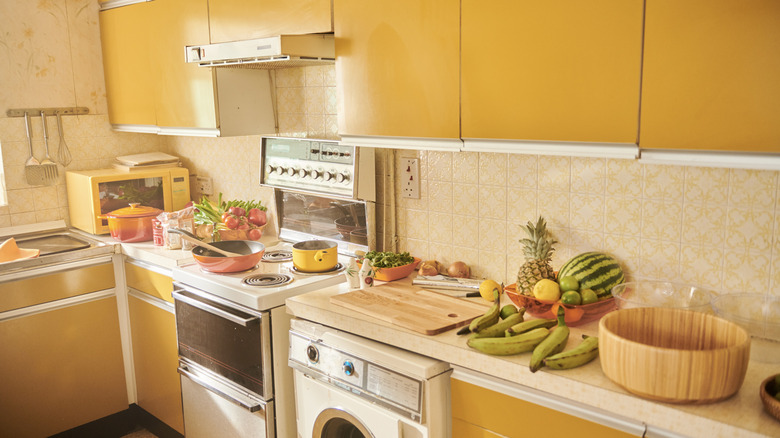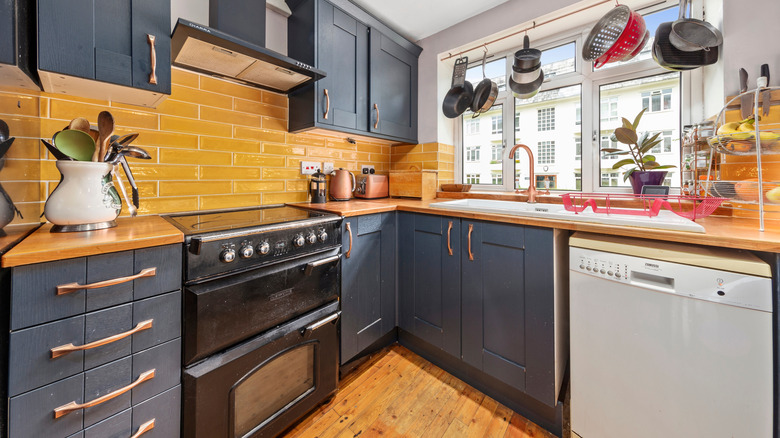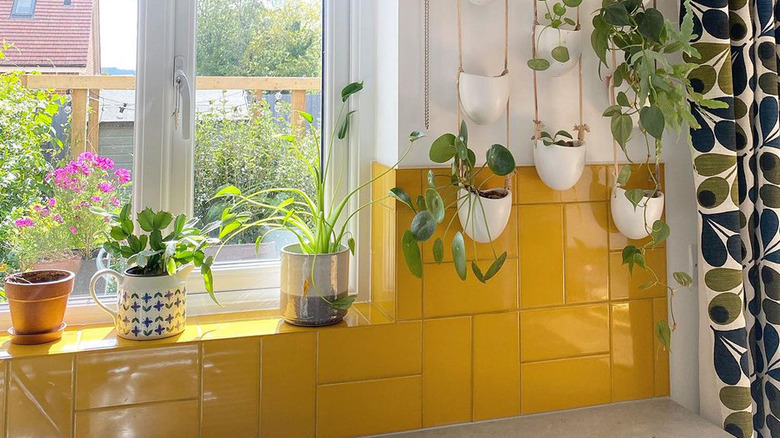The 1970s Kitchen Backsplash Trend That Should Make A Comeback
When the time comes to choose a kitchen backsplash, you've got some materials, like ceramic, are timeless, while others align with current trends, like beadboard, which can give your kitchen a rustic, country touch. Certain retro designs also deserve a comeback, and by looking back at vintage backsplash trends, you can rediscover styles that still feel surprisingly modern. To dive deeper, Food Republic consulted Evelina Juzėnaitė, principal interior designer at Planner 5D, who revealed that one 1970s backsplash trend worth reviving is mustard yellow tiles.
"They reflected the bold, natural color palette characteristic of that era," Juzėnaitė told us. "The '70s saw the popularity of warm, rich shades inspired by nature, such as avocado, burnt orange, and, of course, mustard yellow." Unlike kitchens of the 1970s, many modern kitchens have replaced warm, earthy tones with minimalist designs that feature integrated applications, clean lines, and a neutral color palette of whites, grays, or beiges. In contrast, "Mustard yellow tiles, often combined with wooden cabinets and laminated countertops, added warmth and became the center of attention," Juzėnaitė explained. Contemporary kitchens can feel cold, so adding a mustard yellow backsplash is the perfect way to reintroduce some inviting, 1970s charm.
You don't even need a full renovation to bring this retro style back. Achieve this look by using an epoxy-based paint to refresh your existing tiles, or install a removable laminate backsplash featuring faux mustard yellow tiles.
How can you modernize mustard yellow tiles?
Some trends deserve to go into retirement (like the millennial all-white kitchen), but according to Evelina Juzėnaitė, mustard yellow tiles actually deserve more time in the spotlight thanks to their naturally contemporary vibe. "It's already trendy, bright, yet earthy, adding depth and individuality," she told us. When thoughtfully paired with modern design elements, these tiles only require a few small adjustments to blend seamlessly into a contemporary kitchen.
As Juzėnaitė shared with Food Republic, "It's best to combine it with clean lines, natural materials such as light oak or quartz, and more neutral base tones such as warm white, charcoal, or delicate sage." To create clean lines, consider using larger tiles to reduce the number of grout lines, or paint your grout lines the same color as your backsplash. This will allow you to incorporate smaller, trendier tile designs like subway or checkerboard without making them look too busy.
Another creative way to add mustard yellow tiles into your kitchen is by combining them with other '70s-inspired colors. Think avocado greens, chocolate browns, or burnt oranges. Combine mustard yellow, brown, and orange to create a groovy, retro feel, or pick a dual-color combo like yellow and brown to align with a cozy yet trendy cottagecore vibe.
Cabinetry and countertops that pair well with mustard yellow tiles
The combination of materials you pair with your mustard yellow tiles is critical. This yellow isn't exactly subtle; it's bold, eye-catching, and can quickly dominate a space if you don't balance it out. We recommend avoiding loud, standout shades if you're aiming for a sleek, contemporary look, so to seamlessly incorporate mustard yellow tiling into a modern kitchen, pair it with natural elements like woods, stone, or marble.
The easiest way to bring this balance to life is through your cabinetry and countertops. "[Mustard yellow tile] pairs beautifully with wooden cabinets with flat fronts in light oak or walnut, creating a warm mid-century atmosphere, or with matte black cabinets for a bold, contemporary contrast," Evelina Juzėnaitė told Food Republic. Beyond material choices, cheap and easy upgrades to your kitchen hardware can also make a big impact. Try swapping out your existing hardware for warm teak wood or brass knobs, or experiment with colors like gold or bronze handles to create a cohesive, balanced color scheme and avoid distracting clashes.
"White quartz or talc stone for countertops will help soften the yellow color and give the room a fresh, not overly vintage feel," Juzėnaitė added. Another material that can work for a softer vibe is white Italian marble. For something more natural, spring for a wooden butcher block countertop. "If you want a slight echo of the past, laminated countertops in terrazzo or cream tones are a good choice," Juzėnaitė explained.



